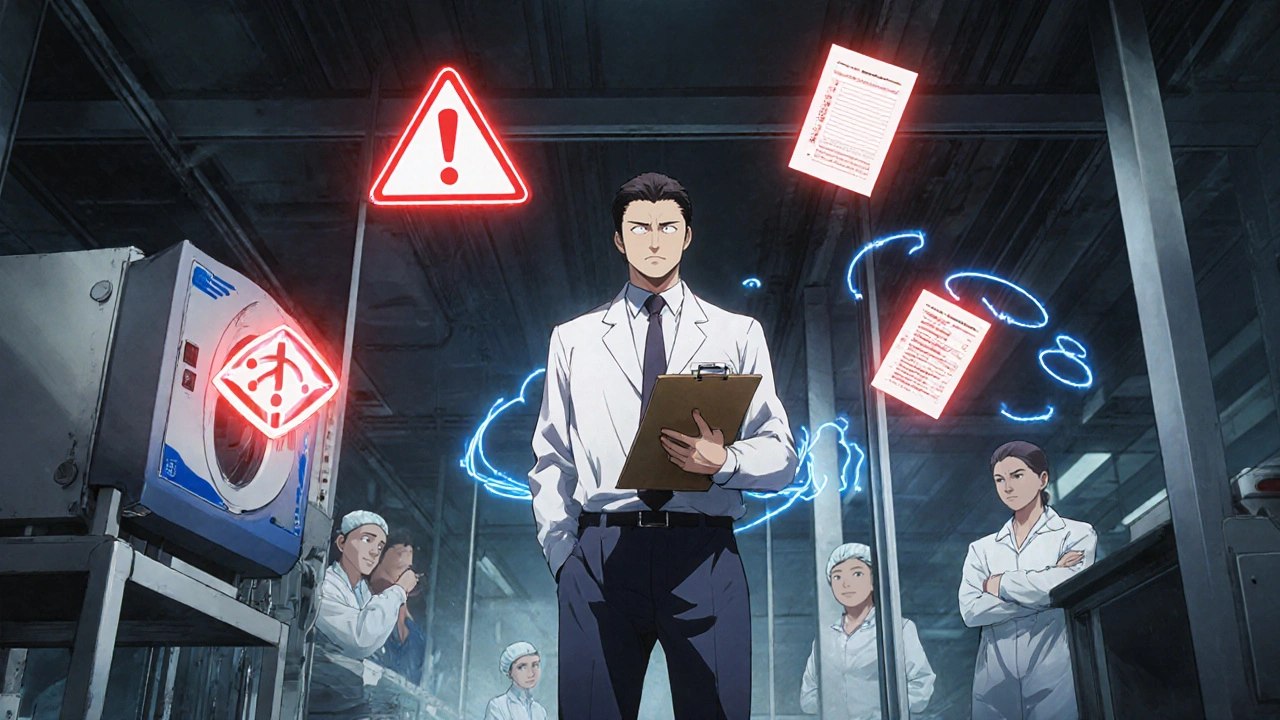What Happens During an FDA Inspection of a Generic Drug Facility?
If you work at a generic drug manufacturing plant, you know the FDA doesn’t show up with a warning. They show up when they’re ready - and they’re watching. In 2025, inspections are more predictable than ever, but also more demanding. The FDA doesn’t just check if you’re following rules. They’re looking to see if your entire operation tells a story of quality - from the moment raw materials arrive to the final pill leaving the packaging line.
The Four Types of FDA Inspections You Might Face
Not every inspection is the same. The FDA uses four main types, each with a different purpose.
- Pre-Approval Inspections (PAIs) - These happen before a new generic drug gets approved. The FDA wants to confirm your facility can actually make the product exactly as described in your application. They’ll compare your equipment, procedures, and test methods to what you submitted. If your stability samples aren’t stored where you said they’d be, or your analytical method doesn’t match the one on file, your approval could stall.
- Routine Surveillance Inspections - These are the most common. The FDA picks sites using a risk-based model. Factors like past inspection history, product risk, and even consumer complaints trigger selection. About 90% of these inspections find acceptable compliance, but that doesn’t mean you can relax. One small gap can turn into a warning letter.
- For-Cause Inspections - Triggered by specific red flags: a whistleblower tip, a spike in adverse events, or a supplier failure. These are intense. Investigators zero in on the problem area, but they still look at your whole quality system. You can’t hide behind a single clean department.
- Follow-Up Inspections - After a warning letter or FDA 483, the FDA comes back. They don’t just check if you fixed the issue. They check if you fixed it the right way - with real changes, not paperwork.
The Six-System Inspection Framework
Every FDA investigator walks into your facility with the same checklist: the six-system approach. They don’t look at everything at once, but they always start with Quality.
- Quality System - Always assessed. This is the backbone. Do you have a strong quality unit? Are they independent? Do they have authority to stop production? FDA 21 CFR 211.22(a) is the rule here. If your quality unit reports to production, you’re already in trouble.
- Facilities and Equipment - Clean rooms, calibration logs, maintenance records. Is your equipment qualified? Are cleaning procedures validated? If your autoclave hasn’t been calibrated in 18 months, that’s an observation.
- Materials - Where do your raw materials come from? Are your suppliers qualified? Do you test incoming batches? The FDA checks your vendor approval process and your incoming inspection records. No exceptions.
- Production - Can you prove your process is controlled? Did you validate your mixing time? Your drying temperature? Your filling speed? They’ll pull batch records and compare them to your validation reports. Any deviation not documented? That’s a red flag.
- Packaging and Labeling - This is where mistakes hurt patients. Are labels accurate? Are barcodes scannable? Is the right blister pack going into the right box? They’ll check your labeling control system and reconciliation logs.
- Laboratory Control - Your lab is under a microscope. Are your methods validated? Are your reference standards traceable? Are stability studies running on schedule? If your HPLC system hasn’t been qualified in two years, or your analysts aren’t trained on the latest method, you’re at risk.

What the FDA Actually Looks At During the Tour
Don’t think the inspectors are just walking around. They’re reading your facility like a book.
They’ll ask to see:
- Deviation reports from the last six months - not just the ones you think are important.
- Non-conformance logs - and how you closed them.
- Equipment qualification records - including installation, operational, and performance qualification (IQ/OQ/PQ).
- Supplier audit reports - and how often you re-audit.
- Process validation protocols and reports - including worst-case scenarios.
- Batch records - for at least three recent batches of the product they’re inspecting.
- Stability study data - and whether storage conditions match what you filed with the FDA.
- Training records - for everyone who touches the product, including contractors.
They’ll ask to see your SOPs. Not just the folder on the shelf - the actual version used on the floor. If your SOP says to clean the mixer after every batch, but the operator skips it on weekends, you’re not compliant. Even if you’ve never been caught.
What Is an FDA 483 - And What Happens After?
If the FDA finds something wrong, they’ll hand you Form FDA 483. It’s not a fine. It’s a list of observations. Each one references a specific regulation - like 21 CFR 211.110 for inadequate testing.
You have 15 business days to respond. This is your chance. A weak response - like “we’ll train staff” - won’t cut it. You need:
- Root cause analysis - not just “someone forgot.”
- Corrective actions - what you did to fix it.
- Preventive actions - what you changed so it doesn’t happen again.
- Timeline - with deadlines and responsible people.
After your response, the FDA reviews it with scientists, legal teams, and regional directors. They decide if your plan is enough. If not, you get a warning letter. If you ignore it, you could face import alerts, consent decrees, or even criminal charges.
The New PreCheck Program - A Game Changer
In 2024, the FDA launched PreCheck. This isn’t a shortcut. It’s a safety net.
If you’re building a new facility or launching a new generic drug, you can submit a Type V Drug Master File (DMF) early. It includes your facility layout, quality system design, and validation plan. The FDA reviews it and gives you feedback - before you spend millions on equipment or run your first commercial batch.
Companies using PreCheck report fewer surprises during PAIs. They know where they stand. They avoid costly redesigns. It’s not mandatory - but if you’re serious about getting approved fast, it’s the smart move.

How to Be Ready - All the Time
You can’t prep for an FDA inspection the week before it happens. That’s like studying for a medical license the night before the test.
Real readiness means:
- Every area of your facility looks like it’s ready for inspection - every day.
- Your SOPs are living documents, updated when processes change.
- Your team knows what to do when an inspector walks in - no panic, no hiding.
- You run mock inspections quarterly - with real FDA-style questions.
- You track your own data - not just to pass audits, but to improve.
Facilities with mature quality cultures don’t just survive inspections. They thrive. The FDA sees it. They spend less time digging and more time asking, “How can we help you get better?”
Data Integrity Is No Longer Optional
In 2025, the FDA is watching your data harder than ever. They’re trained to spot manipulation: deleted files, backdated entries, unexplained overrides. If your LIMS system allows users to edit raw data without audit trails, you’re at risk.
They’ll check:
- Electronic records - are they secure and backed up?
- System access - who can change results?
- Audit trails - are they enabled and reviewed?
- Calibration records - are they signed and dated?
One falsified test result can sink a product line. Don’t risk it.
Final Thought: It’s Not About Passing - It’s About Trust
The FDA doesn’t want to shut you down. They want you to make safe, reliable medicine. If your facility runs like a well-oiled machine - with clear processes, honest data, and a culture that puts patients first - you won’t just pass inspections. You’ll earn their respect.
What happens if I don’t respond to an FDA 483?
Failing to respond within 15 business days is treated as a refusal to cooperate. The FDA will likely issue a warning letter, which can lead to import alerts, product seizures, or even a consent decree. Your ability to sell drugs in the U.S. market will be at serious risk.
Can the FDA inspect without notice?
Yes. Routine and for-cause inspections are often unannounced. The FDA has the legal right to enter any registered facility at any reasonable time. You cannot refuse entry. Facilities that claim they’re "not ready" when inspectors arrive often face harsher scrutiny.
How often do generic drug facilities get inspected?
There’s no fixed schedule. The FDA uses a risk-based model. Facilities with clean records and low-risk products may be inspected every 3-5 years. Those with past issues, high-risk products, or complaints can be inspected annually - or even more frequently. Some high-risk sites are inspected every 12-18 months.
What’s the difference between a warning letter and an FDA 483?
An FDA 483 is a list of observations made during the inspection - it’s not a formal enforcement action. A warning letter is a legal notice from the FDA that your violations are serious enough to require immediate correction. It’s public, carries legal weight, and can trigger further actions like import bans.
Can a facility be approved if it has an FDA 483?
Yes - but only if the observations are minor and you provide a strong, timely response. For Pre-Approval Inspections, if the FDA believes your corrective actions fully address the issues, they can still approve your drug. However, major or repeated findings usually delay or block approval.
What’s the most common reason for an FDA 483 in generic drug facilities?
The most frequent observation is inadequate quality control - especially failure to properly investigate deviations or failures. Other top issues include lack of validated cleaning procedures, incomplete batch records, and poor data integrity practices. These aren’t technical glitches - they’re systemic failures in quality culture.
Is the PreCheck program only for U.S.-based facilities?
No. The PreCheck program is available to all manufacturers - domestic or foreign - who intend to supply drugs to the U.S. market. Many international facilities use PreCheck to avoid delays during their first Pre-Approval Inspection. It’s especially helpful for facilities new to U.S. regulatory expectations.


Mqondisi Gumede
November 26, 2025 AT 19:12Albert Guasch
November 26, 2025 AT 19:50hannah mitchell
November 28, 2025 AT 17:17Vanessa Carpenter
November 29, 2025 AT 05:30Gina Banh
November 30, 2025 AT 18:16Deirdre Wilson
December 2, 2025 AT 14:30Damon Stangherlin
December 3, 2025 AT 22:53stephen riyo
December 5, 2025 AT 07:03Jaspreet Kaur
December 7, 2025 AT 06:10Dan Rua
December 8, 2025 AT 19:24Ginger Henderson
December 8, 2025 AT 20:55Bethany Buckley
December 9, 2025 AT 20:35Amanda Meyer
December 10, 2025 AT 15:42Douglas Fisher
December 12, 2025 AT 13:50